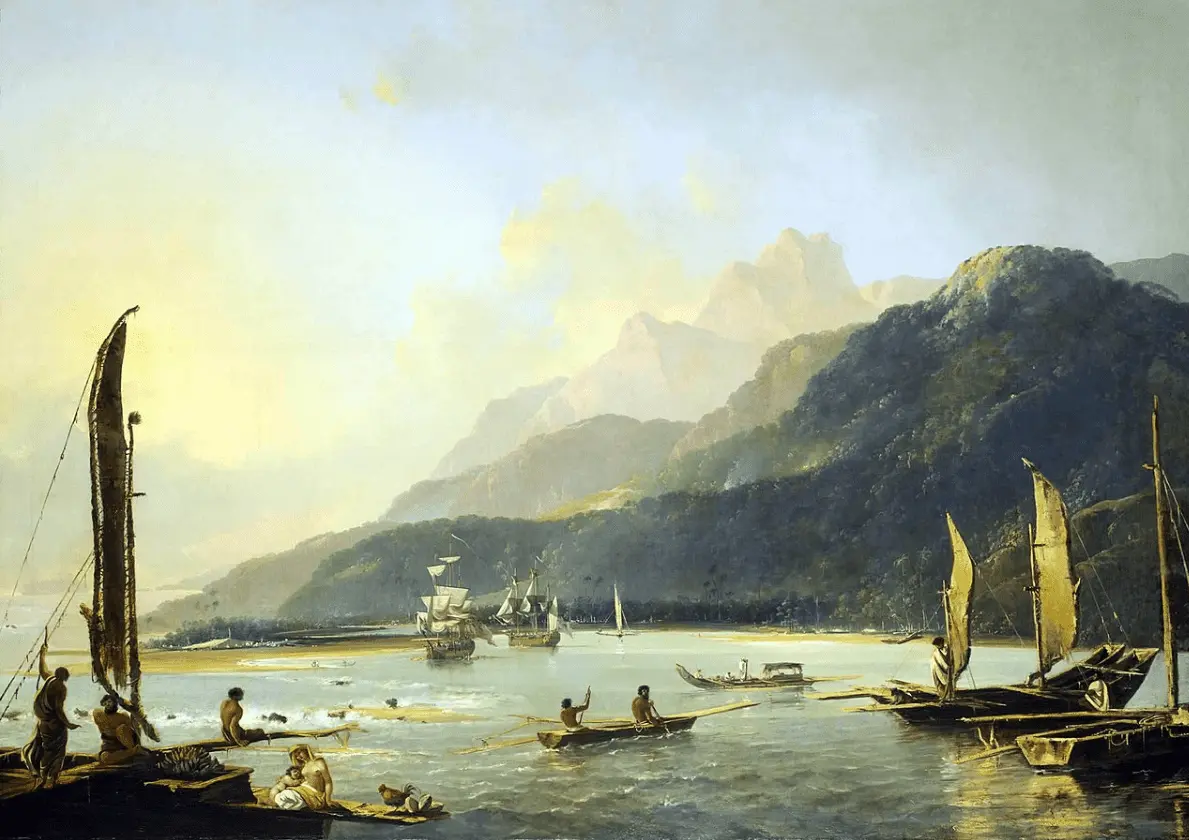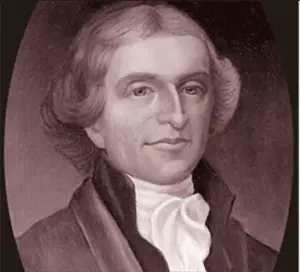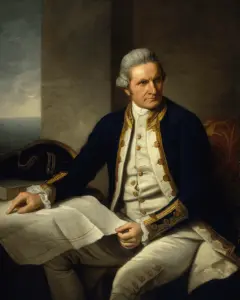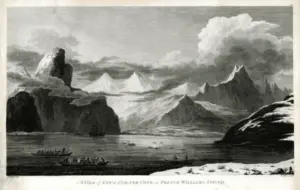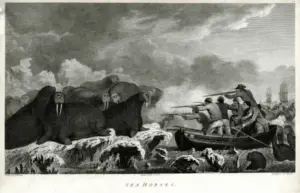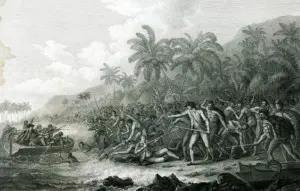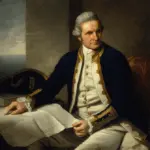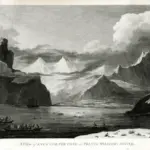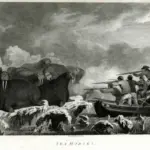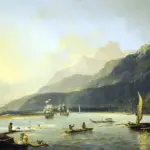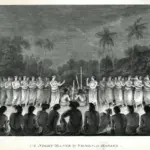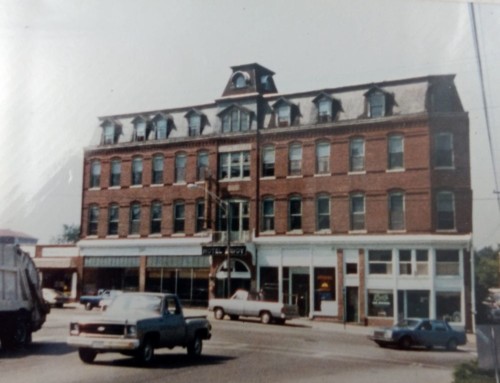Newport, Rhode Island has the largest number of Revolutionary War era shipwrecks in the world. Two of these shipwrecks are thought to be two of history’s most famous ships, Endeavor and Resolution, the two British ships used by the English explorer Captain James Cook on his voyages of discovery. The British purposely sank the Endeavor to block Newport harbor in the Revolutionary War and the Resolution might have been left to rot only a mile away.
Between these two ships, Captain Cook did three voyages mapping large areas of the world and was the first European to discover Australia, New Zealand, and the Hawaiian Islands. On board the Resolution during Cook’s third voyage of discovery was a lone American, John Ledyard, from Groton, Connecticut. This is his story.
Of all the famous American explorers and adventurers the name John Ledyard today is almost forgotten. He was the only American to accompany Cook on his last voyage and was on the beach in 1779 with Cook when Cook was attacked and killed by the natives of Hawaii. After the voyage, Ledyard wrote his account of the adventure and it became a bestseller. He became a celebrity and close friends with Thomas Jefferson, John Paul Jones, and the Marquis de Lafayette.
Ledyard grew up in Groton not far from Fort Griswold. John was the eldest son of Captain John Ledyard, a successful sea captain. After his father’s death, when he was ten years old, his mother sent him to live in Hartford with an appointed guardian, the lawyer Thomas Seymour.
Jared Sparks authored a biography of Ledyard in 1827 and in it he wrote, “His friend wished to quiet his temper by fixing him in some settled pursuit, a career congenial to his taste and fancy.” Restless and bored, Ledyard’s strong will made it difficult for him to stick to anything for long.
He first tried studying law but that didn’t work out and at 19 years old he found himself with no money, few friends, and fewer prospects. Then in 1772 a friend of his grandfather, Dr. Eleazer Wheelock, made him an offer. Wheelock had just founded Dartmouth College two years before and suggested that Ledyard enter the college and study to become a missionary to the Seneca and Oneida tribes. He accepted at once.
At first, he did well at Dartmouth but soon wearied of college life and suddenly withdrew from classes to live for four months among the Indians, learning their way of life and language. But the poverty and general wretchedness of the tribes bothered him.
In a dramatic exit from Dartmouth, he created another of the legends still remembered at the school. Learning to travel by canoe from the Indians he cut down a large tree on the banks of the Connecticut River and built a 40-foot Indian dugout. Loading his belongings aboard the canoe he paddled the 140 miles down the river to his surprised guardian’s home in Hartford.
Like many young men of his time, he decided to go to sea. Sailing in the triangle trade between New England and the West Indies he helped transport molasses, rum, and slaves. At last Ledyard felt he’d found something he loved, sailing on a ship across the oceans of the world. He was 22 years old when he returned from this first voyage and decided to spend the next seven years seeing the world. Signing onto a ship bound for England he arrived in London. After a few months at loose ends, he met Captain James Cook who was signing on a crew for his third voyage of discovery.
Captain Cook had retired after his first two voyages of discovery but came out of retirement when he was offered command of the expedition by the Admiralty. Although it was a secret at the time the expedition’s real goal was the discovery of the famed Northwest Passage. All previous expeditions in search of the passage had been from the Atlantic side of the continent. This time Cook would attempt its discovery from the Pacific side. Based on the publication of a Russian map, by Jacob von Stählin, that showed Alaska as an island there was a great deal of confidence that the expedition would be successful.
Ledyard, who possessed great personal charm, convinced Captain Cook to take him on. He was the only American onboard and since the ship was a Royal Naval vessel he was required to join the Royal Marines to become part of the crew.
The expedition left England on July 12, 1776, before news of the Declaration of Independence reached England. Ledyard would not learn of the Revolutionary War until his return four years later. The expedition consisted of two ships, the HMS Resolution commanded by Captain Cook and the HMS Discovery commanded by Captain Charles Clerke.
After rounding the Cape of Good Hope Captain Cook’s two vessels visited New Holland, New Zealand, Tahiti, and were the first European ships to reach the Hawaiian Islands. They spent ten days there before heading for the North American continent. In March 1778 they reached the coast of North America and sailed up to Vancouver Island.
Cook left Nootka Sound in April 1778 and sailed north along the Alaskan coast looking for inlets that might lead to the Northwest Passage but was forced to turn south. By July he had rounded the Alaskan Peninsula and was able to sail north again visiting the Kamchatka Peninsula in Russia before heading out into the Bering Sea. Cook crossed the Arctic Circle and went as far north as latitude 70 degrees 41’ north before being forced back by the pack ice off Icy Cape, Alaska.
Trading with the Indians Cook’s men purchased 1500 beaver skins for sixpence each. The crews were able to sell the skins when they reached China for $100 apiece, an incredible amount at the time. Ledyard realized that he could make a fortune this way. He would never succeed at this but, only a few years later, John Jacob Astor made his fortune this way.
After several months of exploring, then realizing that it was too late in the season to make another attempt, he sailed for the Hawaiian Islands. The first time Cook visited the Island’s the natives were friendly and Cook was treated almost like a God. However on this trip, after a dispute over a stolen boat, relations turned hostile.
“The people were soured,” Ledyard wrote in his Journal. On the day of Cook’s death, Ledyard and a company of armed marines went ashore with Cook.
Cook attempted to lure the high chief back to the ship to be used as a hostage to compel the natives to obey his demands. The old chief sat down in the sand and refused to move. A crowd of several thousand Hawaiians gathered not sure what was going on. When another chief approached to try and help the high chief Cook struck the man across his face with his sword. The old chief grabbed him and Cook fell to the sand. As Cook tried to rise he was stabbed by another native with a dagger. He fell face down in the water and died.
A battle broke out between the townspeople and Cook’s crew. Four of the Royal Marines were killed and two were wounded. The remaining sailors and marines fired as they fled to their small boat and rowed back to their ship. Dozens of native Hawaiians on the beach were injured or killed.
Historians note that Cook made many uncharacteristic mistakes in his dealings with the Native Hawaiians. Some believe he was ill at the time and not thinking clearly.
- John Ledyard
- John Ledyard
- Captain James Cook
- Cook at Prince William Sound Alaska
- Hunting Walruses
- Woman dancing Hapaee
- Woman dancing Hapaee
